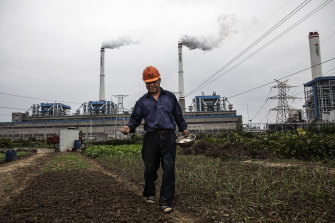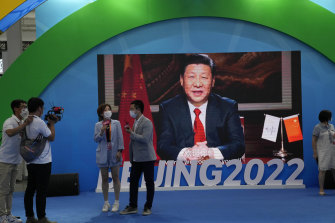Fighting fires at home Xi Jinping makes a two-way bet on climate
Xi Jinping has spent the week working from home, telling his colleagues at the Rome and Glasgow summits that he was “delivering concrete actionsâ€, while quietly trying to put out a fire in his backyard.
China’s economy is on the verge of stagflation, a recession inducing situation where prices rise but economic growth slows. Most of it is being driven by an energy crunch which has seen coal prices surge as winter looms, driving up the cost of production.
Right now, it can’t get enough coal to power its economy, let alone reduce emissions.
Key manufacturing indicators have fallen twice in as many months as a result of rising power prices. The National Bureau of Statistics data was released just before dozens of world leaders arrived in Glasgow.

A man tenders to young plants in front of a coal-fired power station in Hanchuan, Hubei province, China.Credit:Getty Images
Under the cover of COVID, Xi, the President of the world’s largest polluter, chose to stay home and deliver a written statement chock-full of blueprints for a multilateral consensus and “a community for life and natureâ€, rather than face the fundamental question: how is China going to deal with this growing economic and environmental conflict?
Xi told the G20 in Rome via video link that his government had phased out 120 million kilowatts of installed coal-fired power generation in the past 10 years and had installed 100 million kilowatts of wind and solar power. But he failed to mention it had also ordered more than 70 mines across Inner Mongolia to increase production to deliver an extra 220 million metric tonnes a year of coal â€" putting the country on track to produce more domestic coal than ever before.
China is having a bet each way. It is simultaneously positioning itself as a climate leader by committing to net-zero emissions by 2060 while calling for concessions for developing countries â€" a club the superpower counts itself as a member of when convenient.
Ma Jun, veteran Chinese environmental campaigner and director of the Institute of Public and Environmental Affairs in Beijing, says he believes China has moved on from the mantra it has adopted since the Copenhagen climate change conference in 2009.
Advertisement“China had a very firm position of ‘common but differentiated responsibilities’, insisting that the West first deal with its historic emission impacts,†he says. “That position has changed. I think in many ways, it was the people’s voice on local air pollution that opened up new possibilities for China to join the global climate movement.â€

President Xi Jinping in a video at an international Fair for Trade in Services in Beijing. Credit:AP
But old habits are hard to shake. Chinese Foreign Affairs spokesman Wang Wenbin suggested on Monday his country should get carry-over credits for not contributing to emissions in the 19th century.
“Developed countries have unshirkable and historical responsibility since they have been releasing greenhouse gases into the atmosphere for the past 200 years or so of industrialisation,†he says. “For example, the US’ cumulative historical emissions level per capita are eight times that of China.â€
India, a country whose per capita living standards are a tenth of China’s, has a similar justification. Prime Minister Narendra Modi has committed to net-zero by 2070. India has emissions of 1.9 tonnes per capita - a fraction of those of China and the United States. Who is the West to deny either economy access to a century of industrial advancement?
Unfortunately, the climate is not capable of retrospective economic analysis. It works only in the present through floods in Shanxi and fires in Turkey, or in the future by melting polar ice caps.
“Developed countries should not only do more themselves but should also provide support to help developing countries do better,†says Xi.
China is right to call for more technology sharing between developed and developing countries to make this transition possible. But is it genuine about its intentions?
Ma is clear-eyed about the challenges.
“We still have an energy consumption that is highly dependent on coal. We’re still the factory of the world, with a lot of heavy-duty manufacturing. I believe we can only do it with extensive public participation from multiple stakeholders and the first step is access to information,†he told the UK’s Geographical Magazine ahead of Glasgow.
“We need to make sure that China’s national ambitions are clearly distributed locally, down to the provinces and then the cities and then to the carbon-intensive industries. We need to get started.â€
Steve Tsang, the director of the SOAS China Institute at the University of London, has this dose of realpolitik.
Tsang says Beijing is serious about climate change. It absolutely wants to do something about it. He says Xi talks about a beautiful China - a green China - but it is not anywhere near the top of the political agenda. The most important thing is keeping the Communist Party in power.
“China takes part in the big climate conferences not because of climate change, but because having an impact at these global mega events means that China is now a top-tier power,†he says.
“China might still transition to renewables â€" provided the economy can afford it. But if the Chinese economy doesn’t grow at the current rate, and if it can’t afford to make that transformation promise for 2060 â€" then it won’t happen.â€
That’s a big bet to take on a leader that won’t show up to a conference.
Get daily updates on the climate summit that will shape our future. Sign up to our COP26 newsletter here.
Most Viewed in World
0 Response to "Fighting fires at home Xi Jinping makes a two-way bet on climate"
Post a Comment